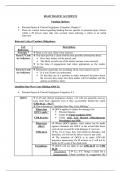Exam (elaborations)
LPC - Personal Injury and Clinical Negligence Revision Notes - 2022/2023
- Module
- LPC - Legal Practice Course
- Institution
- LPC - Legal Practice Course
Fully, comprehensive revision notes for the LPC Personal Injury and Clinical Negligence Exam. I achieved a Distinction using these notes (82%).
[Show more]



